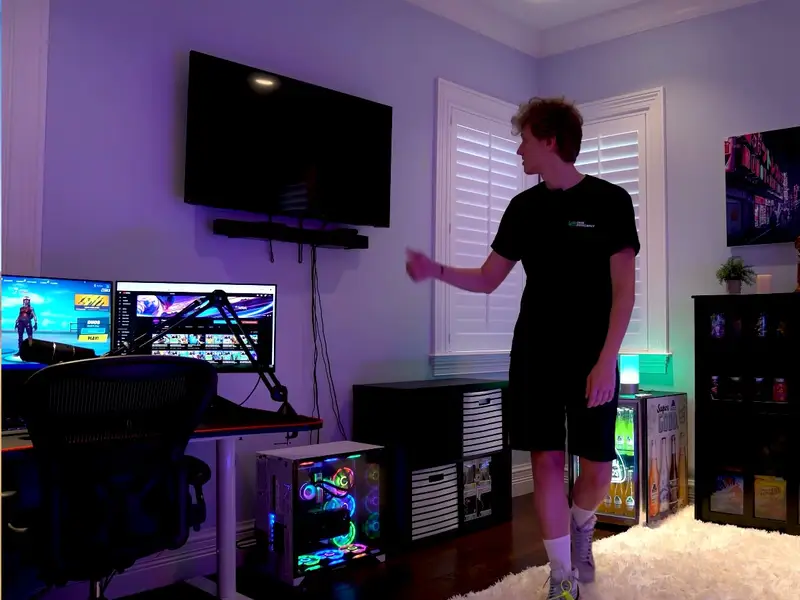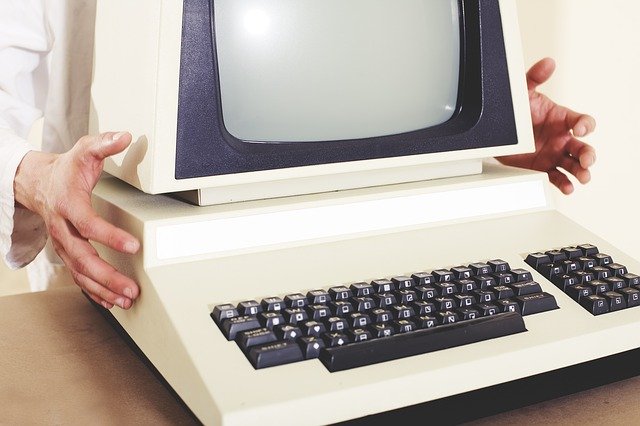In an article by Business Insider, the esports group One Percent gave a tour of their new, luxurious mansion. The impressive house features many attractions, like a piano reportedly played by Frank Sinatra. Much of the house, seen throughout the article, seems like the dictionary definition of “nouveau-riche mansion.” White, clean walls, comfortable furniture, ample places to eat and lounge, etc. However, the most distinct and important sections of the house are the members’ gaming setups, also known as “battlestations.” Each battlestation is equipped with the following (Visual example of a member’s station, Formula’s, below):
- Multiple monitors (rigged specifically for streaming)
- A large ‘gaming chair,’ usually red
- An abundance of LED lights (especially in the keyboards)
- Lots of color coming from every component of the setup
- A colorful PC case, usually set off to the side but still visible
- Recording equipment
Gaming setups have evolved beyond the simple setups of a monitor or tv and a console. Modern gaming stations are often aesthetically pleasing and reflect the personality of the gamer. In fact, the curation of gaming stations have become a culture and game of their own. They not only function as a place to play video games, but act as a representation of individuals.

Back to the Future
The history of the gaming stations is intertwined with the history of home electronics development. The first home-gaming console was the Magnavox Odyssey, released in 1972. But the Odyssey was nothing like the Playstations and Xboxes of the modern day. Magnavox, the sole publisher for the system, released only 29 games for it. While innovative, the Odyssey didn’t catch on nearly as well as the forthcoming Atari consoles would. Instead of home-consoles, gamers back then flocked to video arcades, playing titles like Pac Man, Space Invaders, and Donkey Kong. The jump to the consoles modern gamers are familiar with wouldn’t come until the early 80s. The release of Space Invaders for the Atari VCS in 1980 is seen by many as the beginning of the video game boom of that decade. Atari was the first major name in home-consoles, and while it caused the video game crash of 1983, Atari paved the way for the modern console market.
The history of the personal computer runs almost parallel to the history of the home-console. The earliest computers were titanic machines that took up multiple rooms’ worth of space. Around the same time as the video game crash in the 1970s, according to this article from Tech Crunch, the first true personal computers came about. The Apple II and Commodore 64 were two early pioneers that helped carve out the personal computer niche. The advent of Windows 95 and ethernet cards allowed networking to become a reality, truly revolutionizing gaming. This occurred simultaneously to the Fifth generation of gaming consoles, namely the Playstation and Nintendo 64.

Bridging the Gap
So, how did we go from playing Pac Man in an arcade to having an LED-filled gaming setup at home? The advent of personal computers and home-consoles are certainly two main factors, but the Internet cannot be overlooked. By having the Internet, gamers didn’t have to go out to arcades to play games with others. This meant that gamers could spend more time at home around their game consoles and personal computers. When one is around one particular place for long enough, there is a natural impulse to beautify and customize that space. It’s only logical, then, that battlestations caught on as quickly and powerfully as they did.
As online platforms like forums started catching on, people started sharing their office and gaming setups. In 2009, the subreddit r/battlestations was created as a place for gamers to share these setups. In 2010, the Urban Dictionary entry for “battlestation” was submitted, indicating the spread of the trend. And in 2011, the parallel subreddit r/shittybattlestations was created, showing the concept’s ascension into meme status. It was around the same time that 4chan users started creating battlestation threads, especially the ones on the /b/ board. While the relative age of these facts might make it seem like the ‘battlestation’ trend has lost steam, this is far from the truth. The r/battlestations community has over 1.7 million subscribers currently, and the average post accrues around 100 upvotes.
Battlestation Analysis
Looking at any picture of a gaming station, it can be easy to identify its aesthetic value and worth (or lack thereof). From setups with bright LED lights to ones with a more monochromatic, minimalistic look, the aesthetics of these battlestations runs the gamut.
But why do many gamers put so much time into manicuring their setups, while others have gaming setups that look like this?
A good way to think of a gaming station is to think of it as your desktop wallpaper. Sure, you could have an animated wallpaper with flashing lights and a lo-fi song in the background. But what if you just want a really nice picture of an old boat? The way that gamers construct their battlestations is primarily an aesthetic exercise, and looking through different examples elucidates this choice.
This gaming setup has a very modern flair, with the most notable feature being the wall-mounted, curved monitor. The hardwood desk gives this the feeling of an office, as does the tiny but important plant in the corner. The fact that this person has chosen to use a transparent case for their PC is also a very specific choice. Maybe this person values the mechanical aspect of their PC, or just admires their own craftsmanship.
We see a lot of similar elements with this gaming station, but the addition of the tool bench is important. This tells us that this person values their hands-on-crafting time as much as their gaming, and wants both to be in close proximity.
Gaming Setups as a Metagame
Looking through the all-time top posts of the r/battlestations subreddit, we see many of these similarities cropping up again. LEDs, ‘gamer chairs,’ and multiple monitors make an appearance in all of the top posts save for one minimalistic outlier. These three characteristics seem to form the basis of the current battlestation ‘metagame.’ A metagame is when one uses external factors to affect the game, or goes beyond the supposed limits or environment set by the game” to gain a competitive edge on an opponent. In the case of gaming stations, one can find that edge through their setup. Battlestations have become a metagame within the gaming community as gamers share their most viable and consistently successful builds. The prevalence of these characteristics shows their popularity and ubiquity in the community.
Gaming Setups a Symbol of Wealth and Belonging
A gamer’s setup is not only a reflection of their aesthetic taste, but of their economic status. People may look at some gaming setups in the r/shittybattlestations and think “What the heck is wrong with that person?” But not everyone is able to afford a $2,000 dollar PC and matching accessories. To a lot of people, especially those in less privileged positions, whatever allows them to play games with their friends is all they need. If “whatever” means “a laptop on top of an ironing board,” then so be it.
Modifications cost a pretty penny, especially if you want them to not look cheap. A complete “battlestation desk” can run you as much as $400 on Amazon. If you want to buy a “gaming chair” like what Once Percent has, you might be looking at as much as $150. It’s also worth mentioning that these modifications probably won’t improve your in-game performance. Buying something that you really don’t need, but can show off your wealth through, is known as conspicuous consumption. The idea of conspicuous consumption has been around since time immemorial, and it makes sense that the battlestation idea has fallen prey to this inevitability. The question remains, though, why people follow these trends and shell out cash just for an LED-laden status symbol?
This is a larger philosophical question about wealth, here we will say that it’s about acceptance. Since its inception, Internet culture has revolved around acceptance and segregation (though, ironically, acceptance of mainly white men). Like in all things, the Internet culture quickly developed rules delineating who could ‘join the party’ and who couldn’t. This culture of self-segregation has always persisted, and if tricking out your battlestation is what allows you to break through the barriers and meet more like minded people, then so be it. You want to be a part of the group, right? Then you better pony up and get a glowing keyboard. Battlestation culture isn’t this overtly negative, but it can be in how people feel pressured to buy things just to belong. It’s a kind of peer pressure in this way, though the pressure is unstated.
Ultimately, the metagame of battlestations, like with all other games or cultures, is one of group identity and belonging. You can play games whether or not you have a desk ringed with purple LED bulbs, but will you really be a gamer if you don’t?
The Modern Man Cave
In many ways, a gamer’s battlestation is an extension of themself. Much like teenagers’ rooms or man caves, battlestations are how gamers express themselves in physical space. Furthermore, they are examples of how gamers construct spaces that they find comfortable and liveable. After all, when we play games we want to be as comfortable as possible. People inherently find things familiar or ‘safe’ comfortable, so by looking at someone’s gaming station you can tell a lot about their interests and even needs. The decoration of these spaces will of course depend on financial ability, but even on a budget you can make your space comfortable.
So, the next time you sit down to play some games (or, in my case, go 0-15 in Destiny 2’s PVP mode), consider how your battlestation expresses who you are.
